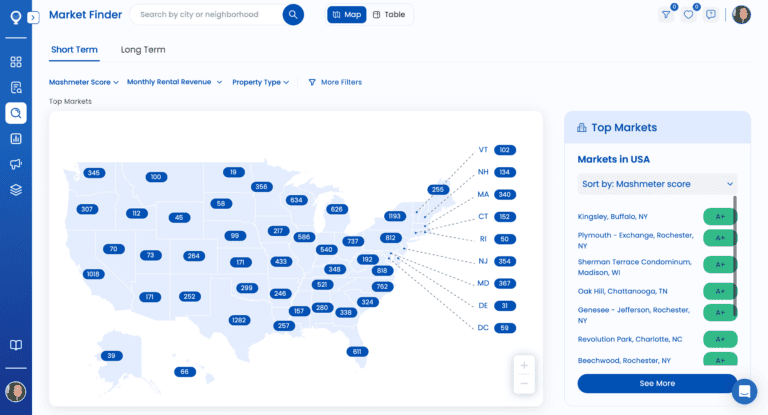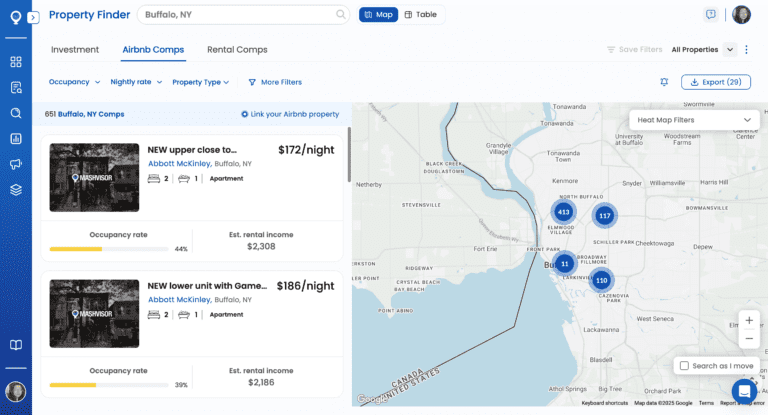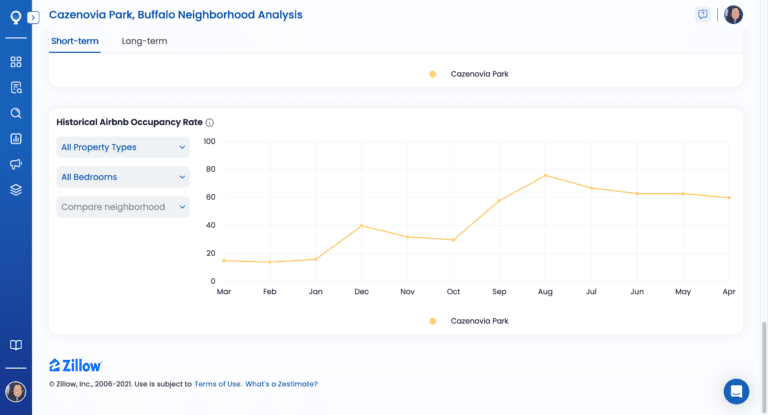According to HNR Hotel News, the US short-term rental (STR) industry is projected to reach pre-pandemic levels of 54.9% by the end of 2025.
It’s no wonder investors have been paying attention to this market.
Unfortunately, STR real estate valuation analysis can be complex for both beginner and experienced investors if they don’t have the right tools.
In this blog, we’ll teach you how to evaluate STR properties accurately using a real estate valuation analysis tool.
What Is STR Real Estate Valuation Analysis?
STR real estate valuation analysis determines a property’s current or projected market value intended for short-term rentals, such as those listed on platforms like Airbnb or Vrbo. This analysis is crucial for investors who want to assess their investment’s potential profitability and viability.
Unlike traditional property valuation, which often focuses on the property’s physical attributes and comparable sales, STR valuation incorporates additional factors unique to short-term rentals. These factors include:
- Income potential: Evaluating the property’s ability to generate rental income based on daily rates and occupancy rates.
- Seasonality and demand: Understanding how different times of the year affect occupancy and pricing, which can significantly impact revenue.
- Operating expenses: Accounting for costs specific to short-term rentals, such as maintenance, cleaning fees, utilities, and management fees.
- Market trends: Analyzing local market conditions, tourism trends, and the regulatory environment that can influence demand and profitability.
By conducting a comprehensive STR real estate valuation analysis, you can make informed real estate investing decisions, set competitive pricing, and implement strategies to maximize your return on investment (ROI).
Why You Need a Real Estate Valuation Analysis Tool for STRs
Investing in short-term rentals requires precise, data-backed decisions to maximize returns and manage risks effectively. Here’s why a dedicated real estate valuation analysis tool is indispensable for STR investors:
Time Efficiency
Gathering and processing various data points—from local market trends to occupancy rates—demands significant effort. A real estate valuation analysis tool rapidly aggregates data from multiple reliable sources, drastically reducing the time spent on research.
Data Accuracy
Manual valuation often leads to inconsistencies due to human error or outdated information. In contrast, digital real estate valuation analysis tools continuously update data in real time, ensuring that your analysis reflects the latest market conditions.
Consistency
With an automated tool, the valuation process is standardized, which removes the subjectivity inherent in manual estimates. This consistency boosts your confidence in the figures and helps you make more informed investment decisions.
A real estate valuation analysis tool for STRs isn’t just a nice-to-have. It’s essential for staying competitive in a dynamic market.
STR Real Estate Valuation Analysis in 5 Easy Steps
If you want to break into or expand your presence in the short-term rental market, you’ll need a systemic approach to property valuation. Here’s a detailed guide outlining the five essential steps to accurately assess an STR investment’s potential:
Step 1: Identify Your STR Investment Goal
Begin by clarifying your overall objective. Are you looking for a property to supplement your income, or are you aiming for a full-time STR business? Define your expected level of involvement, risk tolerance, and investment horizon. A clear goal sets the foundation for choosing the right market and property type.
Step 2: Select Your Market Using Real Estate Data
After determining your investment goal, the next step is identifying the location with the best potential. You must analyze local tourism trends, occupancy rates, and competitive supply. Use data-driven platforms like Mashvisor to find high-demand regions. Choosing the right market can mean the difference between a steady revenue stream and a money pit.

Using Mashvisor’s Market Finder, you can easily identify the location with the best investment potential.
Step 3: Analyze Comparable Properties (Comps)
Once you’ve selected a promising market, gather Airbnb data on similar properties in the area.
Look for listings on popular STR platform, and study their performance metrics. Evaluating comparable properties (often called “comps”) helps you understand prevailing pricing trends, occupancy levels, and the overall competitive landscape. Adjust your analysis by considering property-specific factors like amenities, size, location, and unique selling points.

Mashvisor can show active Airbnb listings in the market of your choice.
Step 4: Calculate Cash Flow and ROI
A crucial aspect of any STR investment is understanding its financial viability.
Use your preferred real estate valuation analysis tool or Airbnb calculator to compute projected cash flow. It considers expected rental income against operating expenses such as maintenance, cleaning, utilities, and management fees.
Then calculate your ROI using metrics like the cap rate or cash-on-cash return. Accurate cash flow and ROI calculations help you assess whether the potential income justifies the investment cost and ongoing expenses.

Each property page listed on Mashvisor includes a calculator that computes projected cash flow and ROI for both short-term and long-term rental investments.
Step 5: Factor in Seasonality and Occupancy Rates
STR markets are susceptible to seasonal fluctuations.
Look into historical occupancy rates and seasonal trends in your chosen market. This analysis should adjust your revenue forecasts based on peak travel seasons, potential slow periods, and local events that might drive short-term surges or declines in Airbnb demand.
By understanding these patterns, you can fine-tune your pricing strategy and occupancy expectations and ensure that your projections reflect the true market dynamics.

You can use Mashvisor’s Neighborhood Analysis tool to look into historical occupancy rates and seasonal trends in your chosen market.
After compiling all the necessary data using your real estate valuation analysis tool, it’s time to make an informed decision.
Review the insights from each step, including your investment goals, market data, comps, financial calculations, and seasonal adjustments. Weigh the potential rewards against the risks and decide whether to move forward with the purchase, adjust your strategy, or explore other properties. A well-rounded analysis gives you clarity and confidence when making a sound investment decision.
Common Mistakes in STR Valuation and How to Avoid Them
Accurate STR valuation is essential for making the right investment decisions, but it’s easy to fall into common traps that skew your analysis. Here are some of the most frequent mistakes and practical advice on avoiding them:
1. Ignoring Local Regulations
Many investors overlook local laws and zoning restrictions that affect short-term rentals. Regulation changes, licensing requirements, and neighborhood restrictions can dramatically impact occupancy rates and permissible operations.
How to avoid this mistake:
- Do your research. Regularly check with local government websites and news outlets to stay updated on regulatory changes. Mashvisor also has a dedicated page for short-term rental regulations in over 400 cities in the US.
- Consult experts. Engage with local real estate agents or legal advisors who specialize in STR regulations to ensure you’re compliant and aware of any impending changes.
2. Underestimating Operating Expenses
Investors sometimes use overly optimistic assumptions, failing to account for costs such as higher cleaning fees, frequent maintenance, marketing expenses, and property management fees that are unique to the STR model.
How to avoid this mistake:
- Include all costs. Create a detailed expense spreadsheet that includes both fixed and variable costs.
- Use data-driven tools. Leverage advanced real estate valuation analysis tools that integrate comprehensive expenses data to ensure you’ll get realistic revenue and expense forecasts.
3. Failing to Adjust for Occupancy Fluctuations
Seasonality is a hallmark of the STR market, and ignoring seasonal trends can lead to inflated revenue forecasts. Relying on peak season data year-round skews profitability assumptions.
How to avoid this mistake:
- Analyze historical data. Use past occupancy rates and seasonal trends to adjust your revenue projections.
- Plan for multiple scenarios. Run multiple scenarios (peak, average, and off-season) to better understand income variations and plan for leaner periods.
4. Overvaluing the Property Based on Emotional Decisions
Investors may become emotionally attached to a property, leading to overestimating its performance. This bias can result in overpaying or ignoring potential flaws that affect long-term profitability.
How to avoid this mistake:
- Stick to data. Base your valuation on concrete Airbnb metrics and market comparisons rather than personal sentiment.
- Use a third-party evaluation. Consider hiring an appraiser or consulting with a professional you trust to validate your analysis objectively.
5. Relying Solely on Outdated or Incomplete Data
Using outdated market data or a single source for insights can result in an inaccurate valuation. Market dynamics can shift rapidly, especially in the STR sector.
How to avoid this mistake:
- Use real-time tools. Access automated valuation tools that continuously update with the latest market insights.
- Diversity data sources. Combine data from multiple reputable sources to build a firm valuation.
By steering clear of these common mistakes, you can make more informed decisions and better manage risk.
Top Features to Look for in a Real Estate Valuation Analysis Tool
When it comes to analyzing short-term rental properties, a reliable valuation analysis tool can make all the difference. The right tool offers not only accuracy in numbers but also actionable insights, streamlined reporting, and seamless integration with the tools you use every day. Consider the following key features:
Accuracy and Data Sources
A top-notch valuation analysis tool should be built on a foundation of reliable, up-to-date data. Look for software aggregating information from multiple trusted sources such as MLS databases, local government records, and real-time market feeds. Features to prioritize include:
- Comprehensive data integration: The tool should pull data from popular rental platforms (like Airbnb and Vrbo), historical market trends, and local sales comparables.
- Real-time updates: Continuous data updates ensure that your valuation reflects current market conditions, helping you respond quickly to market changes.
- Validated data sources: To ensure accuracy and credibility, opt for platforms that provide transparency about where the data comes from.
Ease of Use and Reporting
You can benefit significantly from tools that are not only powerful but also user-friendly. Key aspects to look for include:
- Intuitive dashboards: You’d want a clean, interactive interface that displays key metrics like Airbnb occupancy rates, rental income projections, and cash flow in an easily digestible format.
- Customizable reports: You should be able to generate and export detailed reports tailored to your investment criteria, which will clarify comparisons and decision-making.
- User support and tutorials: Comprehensive support, such as tutorials, help centers, or live chat support, will significantly reduce your learning curve.
Integration With Rental Platforms
Integration with rental platforms is not merely a convenience but a necessity. Look for features that include:
- Data syncing: The tool should be able to automatically import data from rental management platforms like Airbnb or Vrbo to streamline your analysis of occupancy trends, seasonal adjustments, and Airbnb pricing strategies.
- API availability: Some advanced tools offer API connections that enable you to customize data flows and integrate the analysis tool with other investment software you might be using.
The right real estate valuation analysis tool transforms raw data into meaningful decisions, ultimately enhancing your investment strategy and profitability. By focusing on the three primary features mentioned above, you can ensure you’re equipped with a tool that simplifies the valuation process and delivers actionable insights.
Why Mashvisor Is the Best STR Real Estate Valuation Analysis Tool in 2025
When analyzing short-term rental properties, having a tool that combines reliable data, intuitive design, and powerful integrations is essential. Mashvisor is the best solution for STR real estate valuation in 2025 by delivering on all these fronts. Here’s why:
1. Comprehensive and Accurate Data Integration
Mashvisor aggregates extensive datasets from trusted sources, including MLS listings, local market trends, and real-time rental performance metrics. This means you get a 360-degree view of the market—from historical data to current listings—ensuring that every valuation is based on the most accurate information available.
By offering insights into comps, occupancy rates, and seasonal trends, Mashvisor can help you pinpoint opportunities that may otherwise be missed.
2. Intuitive, User-Friendly Interface
One of Mashvisor’s greatest strengths is its easy-to-navigate dashboard. The platform converts complex datasets into clear, interactive visualizations, making it simple to understand critical metrics such as rental income projections, cash flow analysis, and potential ROI. The user-friendly design will minimize your learning curve and streamline your decision-making process.
3. Real-Time Data and Predictive Analytics
In a fast-moving market like short-term rentals, outdated data can be the difference between a profitable investment and a missed opportunity.
Mashvisor continuously updates its datasets to ensure that the valuation outputs reflect the most current market conditions. Its predictive analytics also anticipate seasonal fluctuations and changing occupancy rates to empower you to plan ahead and adjust your strategies as needed. This real-time insight is invaluable for managing risk and capturing emerging market trends.
4. Seamless Integration With Rental Platforms
Mashvisor excels at pulling data directly from major rental platforms like Airbnb and Vrbo. This integration automates the data collection process and synchronizes key performance metrics, enabling you to monitor property performance without switching between multiple tools.
By bridging the gap between data gathering and actionable insight, Mashvisor provides a cohesive view of market dynamics tailored specifically for STR investors like you.
5. Strategic Insights for Smarter Investment Decisions
Beyond raw data, Mashvisor’s platform offers powerful predictive models and comprehensive reporting features that can help you accurately forecast future income and expenses.
The tool translates complex information into actionable insights to allow you to compare different markets, analyze property performance, and ultimately, confidently make informed investment decisions. This strategic foresight represents the competitive edge needed in a rapidly evolving STR landscape for many.
If you’re seeking a reliable, all-in-one solution, Mashvisor not only meets the demands of today’s dynamic market but also sets the standard for tomorrow’s investment strategies.
Investing Smarter With STR Real Estate Valuation Analysis Tools
In today’s dynamic STR market, leveraging advanced analysis tools like Mashvisor is key to making confident investment decisions. It synthesizes data, predicts market trends, and streamlines complex calculations, empowering investors like you to maximize returns while minimizing risk.
Embrace a smarter approach to property investment by trying Mashvisor for its unparalleled insights and ease of use.



















 English (US) ·
English (US) ·